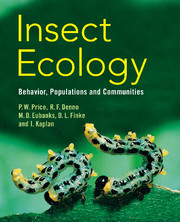Book contents
- Frontmatter
- Contents
- Preface
- Acknowledgments
- Part I Introduction
- Part II Behavioral ecology
- Part III Species interactions
- 4 Plant and herbivore interactions
- 5 Lateral interactions: competition, amensalism and facilitation
- 6 Mutualisms
- 7 Prey and predator interactions
- 8 Parasite and host interactions
- Part IV Population ecology
- Part V Food webs and communities
- Part VI Broad patterns in nature
- Glossary
- References
- Author Index
- Taxonomic Index
- Subject Index
- Plate section
- References
7 - Prey and predator interactions
from Part III - Species interactions
Published online by Cambridge University Press: 05 June 2012
- Frontmatter
- Contents
- Preface
- Acknowledgments
- Part I Introduction
- Part II Behavioral ecology
- Part III Species interactions
- 4 Plant and herbivore interactions
- 5 Lateral interactions: competition, amensalism and facilitation
- 6 Mutualisms
- 7 Prey and predator interactions
- 8 Parasite and host interactions
- Part IV Population ecology
- Part V Food webs and communities
- Part VI Broad patterns in nature
- Glossary
- References
- Author Index
- Taxonomic Index
- Subject Index
- Plate section
- References
Summary
In Chapter 4 we learned how plants and herbivores can influence each other's abundance, distribution and evolution. Here we consider another important inter trophic level relationship that can have widespread ecological and evolutionary effects on biological communities, the interaction between prey and their predators. In an ecological sense, predators can dramatically affect the abundance and distribution of their prey populations, and reciprocal effects of prey on their predators are also inevitable, as prey are obviously an important food source for predators. Likewise, the diverse feeding habits of predators form linkages that are responsible for the flow of energy through food webs. Predation can also be a powerful evolutionary force with natural selection favoring more effective predators and less vulnerable prey. Thus, it is imperative that we understand the process of predation and its complex effects on species interactions, and population and community dynamics. In the sections that follow, we explore critical elements of prey–predator interactions, namely how prey and predators interact to affect each other's long-term population dynamics, what factors stabilize prey–predator interactions and promote their persistence, how multispecies interactions influence the role of predation in complex food webs, the contribution of behavior to a predator's total impact on prey populations, and how predators and prey have reciprocally influenced each other's evolution.
What is a predator?
In a very general sense, predation can be viewed as the consumption of one living organism (the prey) by another organism (the predator). Usually the whole prey item is killed and eaten. If the prey organism in question is a plant, then this general definition of predation includes herbivory. However, whole plants are usually only killed and eaten by a single predator when the plant is in the seed or seedling stage. Hence the terms seed predator and seedling predator are in common usage. In the context of this chapter, however, we restrict our definition of predation to acts of carnivory in which animals consume other animals. We define predators as animals that kill and consume all or parts of their prey, and require many prey items to reach maturity. This definition distinguishes predators from parasitoids, such as some small wasps and flies, which require and eat only one prey item during their life span. Parasitoids are free living as adults, and lay their eggs in or on a host. Larvae hatch from the eggs and live parasitically in or on the host, eventually killing it. For conceptual simplicity we discuss predators and parasitoids as representing distinct biological groups; however, the line distinguishing predators from parasitoids is often blurred, with biological reality perhaps better represented as a continuum rather than discrete categories.
- Type
- Chapter
- Information
- Insect EcologyBehavior, Populations and Communities, pp. 268 - 303Publisher: Cambridge University PressPrint publication year: 2011
References
- 2
- Cited by



